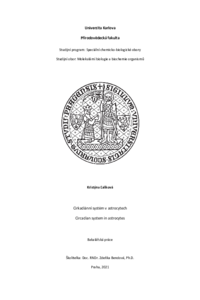Cirkadiánní systém v astrocytech
Circadian system in astrocytes
bachelor thesis (DEFENDED)

View/
Permanent link
http://hdl.handle.net/20.500.11956/126264Identifiers
Study Information System: 230913
Collections
- Kvalifikační práce [20809]
Author
Advisor
Referee
Honc, Ondřej
Faculty / Institute
Faculty of Science
Discipline
Molecular Biology and Biochemistry of Organisms
Department
Department of Physiology
Date of defense
1. 6. 2021
Publisher
Univerzita Karlova, Přírodovědecká fakultaLanguage
Czech
Grade
Excellent
Keywords (Czech)
cirkadiánní systém, hodinové geny, astrocyty, gliotransmise, vápníková signalizace, glutamát, ATPKeywords (English)
circadian system, clock genes, astrocytes, gliotransmission, calcium signaling, glutamate, ATPCirkadiánní systém ovlivňuje téměř všechny buňky v těle savců. Mezi tyto buňky patří i astrocyty, které spolu s mikrogliemi a oligodendrocyty představují hlavní typy gliových buněk nacházejících se v mozku. První kapitola této práce představuje shrnutí charakteristik cirkadiánního systému a zaměřuje se především na molekulární podstatu jeho fungování. Druhá kapitola je věnována astrocytům, astrocytární vápníkové signalizaci a procesu gliotransmise. Třetí a poslední kapitola obě výše uvedená témata spojuje a pojednává o cirkadiánním systému v astrocytech. Uvádí důkazy existence astrocytárních cirkadiánních oscilací a fyziologické důsledky jejich působení. Velká pozornost je věnována cirkadiánním rytmům v gliotransmisi, a to se zaměřením na gliotransmitery ATP a glutamát. Jako nejpůsobivější výstup cirkadiánního systému v astrocytech je uvedena účast na udržování rytmické aktivity hlavního cirkadiánního oscilátoru lokalizovaného v suprachiasmatickém jádře hypothalamu. Klíčová slova: cirkadiánní systém, hodinové geny, astrocyty, gliotransmise, vápníková signalizace, glutamát, ATP
The circadian system affects almost all cells in the mammalian body. These cells include astrocytes, which together with microglia and oligodendrocytes represent the main types of glial cells found in the brain. The first chapter of this thesis presents a summary of circadian system characteristics and focuses mainly on the molecular mechanism underlying its functioning. The second chapter is devoted to astrocytes, astrocyte calcium signaling, and the process of gliotransmission. The third and last chapter connects both topics and discusses the circadian system in astrocytes. It presents evidence of astrocytic circadian oscillations existence and physiological consequences of its action. Great attention is paid to circadian rhythms in gliotransmission, with a focus on gliotransmitters ATP and glutamate. As the most impressive output of the circadian system of astrocytes is presented the participation in maintaining the rhythmic activity of the main circadian oscillator located in the suprachiasmatic nucleus of the hypothalamus. Key words: circadian system, clock genes, astrocytes, gliotransmission, calcium signaling, glutamate, ATP
